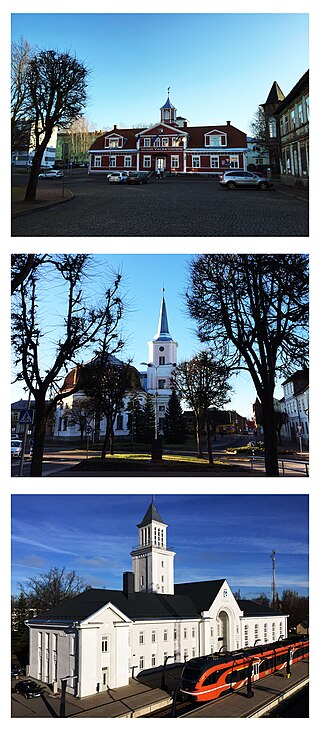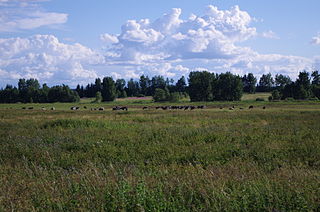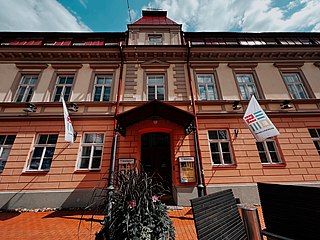
Tartu is the second largest city in Estonia after Tallinn. Tartu has a population of 97,435. It is 186 kilometres southeast of Tallinn and 245 kilometres northeast of Riga, Latvia. Tartu lies on the Emajõgi river, which connects the two largest lakes in Estonia, Lake Võrtsjärv and Lake Peipus. From the 13th century until the end of the 19th century, Tartu was known in most of the world by variants of its historical name Dorpat.

The University of Tartu is a public research university located in the city of Tartu, Estonia. It is the national university of Estonia. It is also the largest and oldest university in the country. The university was founded under the name of Academia Gustaviana in 1632 by Baron Johan Skytte, the Governor-General of Swedish Livonia, Ingria, and Karelia, with the required ratification provided by King Gustavus Adolphus, shortly before the king's death on 6 November in the Battle of Lützen (1632).

Narva is a municipality and city in Estonia. It is located in the Ida-Viru County, at the eastern extreme point of Estonia, on the west bank of the Narva river which forms the Estonia–Russia international border. With 53,626 inhabitants Narva is Estonia's third largest city after capital Tallinn and Tartu.

Pärnu is the fourth-largest city in Estonia and third in terms of the ethnic Estonian population. Situated in southwest Estonia, Pärnu is located 128 kilometres (80 mi) south of the Estonian capital, Tallinn, and 176 kilometres (109 mi) west of Estonia's second-largest city, Tartu. The city sits off the coast of Pärnu Bay, an inlet of the Gulf of Riga, which is a part of the Baltic Sea. In the city, the Pärnu River drains into the Gulf of Riga.

Valga is a town in southern Estonia and the capital of Valga County and Valga Parish. Until their separation in 1920, Valga and the town of Valka in northern Latvia were one town. They are now twin-towns. The area of Valga is 16.5 square kilometres and that of Valka is 14.2 km2 (5.5 sq mi). Their populations are respectively 12,261 and 6,164. On 21 December 2007 all border-crossing points were removed and roads and fences opened between the two countries with both countries joining the Schengen Agreement.

Ida-Viru County is one of 15 counties of Estonia. It is the most north-eastern part of the country. The county contains large deposits of oil shale - the main mineral mined in Estonia. Oil shale is used in the production of shale oil and in thermal power plants. The capital of the county is the town of Jõhvi which is administratively united with the Jõhvi Parish; nevertheless, Narva is the largest town in the county in terms of population and at the same time the third largest city in Estonia after Tallinn and Tartu.

Tartu County is one of 15 counties of Estonia.

Jõgeva is a small town in Estonia with a population of around 5000 people. It is the capital of Jõgeva Parish and Jõgeva County.

Tartu Airport is an airport in Reola, Ülenurme Parish, 5.9 nautical miles south southwest of Tartu, the second largest city in Estonia. It is also called Ülenurme Airport due to its proximity to the village of Ülenurme. The Tallinn–Tartu–Võru–Luhamaa highway (E263) passes near the airport.

Baltic Station is the main railway station in Tallinn, Estonia, and the largest railway station in Estonia. All local commuter, long-distance and international trains depart from the station.

The Ülikooli Street is a street in the center of Tartu in Estonia. Named after the University of Tartu whose main building is located on this street, it runs through the business district, passes behind the Town Hall building, and hosts a number of University-related facilities, including the university cafe, Von Bock House, the university book shop and the old Faculty of Chemistry building, which is also called the Marx Building. The Barclay Square, location of the Barclay de Tolli bust, and the Pirogov park, location of the Nikolay Pirogov statue, are adjacent to the street.

Tartu Cathedral, earlier also known as Dorpat Cathedral, is a former Catholic church in Tartu (Dorpat), Estonia. The building is now an imposing ruin overlooking the lower town. About a third of the cathedral has been renovated. In the part of it that has been renovated is now located the museum of the University of Tartu, which the university also uses for major receptions.

Kiidjärve is a village in Põlva Parish, Põlva County in southeastern Estonia. It is located about 9 km (6 mi) north of the town of Põlva and about 30 km (19 mi) southeast of the city of Tartu, by the Tartu–Pechory railway and the Ahja River. The village territory includes Saesaare Reservoir with hydroelectric power station and Valgesoo bog.
Koorvere is a village in Põlva Parish, Põlva County in southeastern Estonia. It is located about 9 km (6 mi) northwest of the town of Põlva and about 31 km (19 mi) southeast of the city of Tartu, on the crossing of the Põlva–Reola road and Ahja River.

University of Tartu Botanical Garden, is a botanical garden in Tartu, Estonia. It belongs to the University of Tartu.

Raadi-Kruusamäe, or Raadi for short, is a neighbourhood of Tartu, Estonia. It has a population of 4,498 and an area of 2.83 km2 (1.09 sq mi). Raadi is mainly suburban area.

University of Tartu Viljandi Culture Academy is an Estonian institution of higher education, situated in the provincial town of Viljandi, central Estonia. The UT Viljandi Culture Academy merged with the University of Tartu in 2005. The UT VCA has been teaching professional higher education and performing applied research within information science, culture education and creative arts since 1952. The academy has about 1000 students, half of whom are open university students. The teaching and instruction are based on the continuity and sustainability of Estonian native culture enriched by new impulses which widen the notion of traditional culture. As of 2021, the Director of the institution is Juko-Mart Kõlar.

The Estonian Sports and Olympic Museum, founded in 1963 and modernized in 2020, is the largest sports museum in the Baltic states. The museum is located on Rüütli street in Tartu, Estonia. Before 2016, Estonian Sports and Olympic Museum was named Estonian Sports Museum.

Tartu Town Hall is the seat of the city government of Tartu, Estonia. It is located on Town hall square, in the city centre.

Uppsala House is one of the oldest wooden buildings in Tartu, Estonia. It is close to St John's Church in the northern part of the Old Town. The house was renovated in cooperation with Tartu's sister city of Uppsala in Sweden, and was operated as a five-bedroom guest house until 2010. Since then, it has served as the office of the Department of Public Relations of Tartu City Government.




















